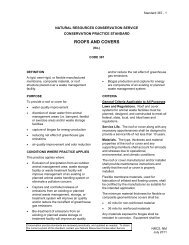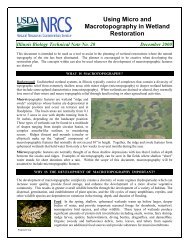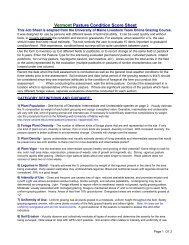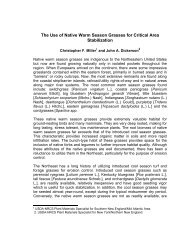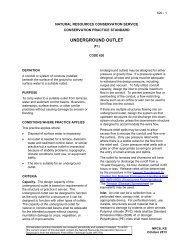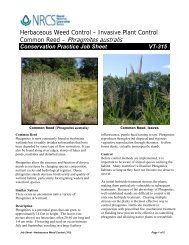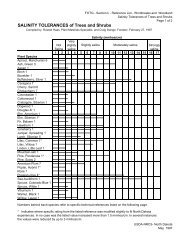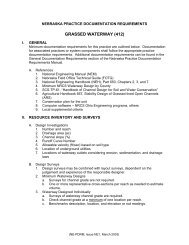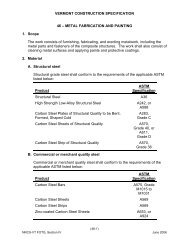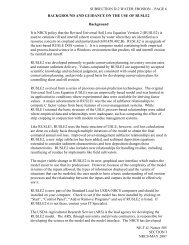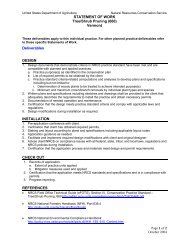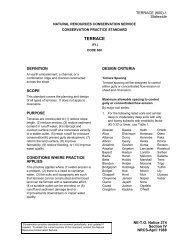You also want an ePaper? Increase the reach of your titles
YUMPU automatically turns print PDFs into web optimized ePapers that Google loves.
CS-BW-382-11. ScopeCONSTRUCTION SPECIFICATIONNATURAL RESOURCES CONSERVATION SERVICEFENCE - BARBED WIRE(Ft.)CODE 382The work shall consist of furnishing and installing <strong>barbed</strong> <strong>wire</strong> fences, including gates, posts, bracesand fittings in accordance with the Conservation Practice Standard, <strong>Fence</strong>, 382, this constructionspecification and as shown on related drawings.2. Wire Spacing and StrandsBarbed <strong>wire</strong> fences shall have a minimum of four <strong>wire</strong>s for farm borders. A minimum of three <strong>wire</strong>sshall be used for cross fencing or excluding larger livestock from special areas such as wildlife,forested, or other special use areas. Wires shall be spaced approximately an equal distance apart.For large animals the top <strong>wire</strong> shall be at least 42 in. high and placed 2 in. below the top of post onwood posts and 1 in. below the top on steel posts. For sheep or goats the top <strong>wire</strong> strand will be atleast 36 in. above ground. The bottom <strong>wire</strong> shall be 4 to 6 in. above ground for small animals likegoats or sheep, and 12 to 18 in. above ground level for large animals like cows or horses.For sheep and goats use at least five strands of <strong>barbed</strong> <strong>wire</strong>.3. Type of WireEach line <strong>wire</strong> shall consist of two twisted strands of 12 ½-gauge <strong>wire</strong> or high tensile strength <strong>wire</strong> of15 ½-gauge. Attach <strong>wire</strong>s to the side of the post closest to the livestock. On corners or in curves,place <strong>wire</strong> on outside of posts.4. Pull AssembliesTwo posts with braces shall be spaced at intervals not to exceed 1,320 ft. in straight, level sections ofthe fence. Wires must be kept tight.5. Post Spacing, Length, and DepthSet posts 12 ft. to 16 ft. apart unless stays are used between posts, and then the spacing shall notexceed 30 feet. Space stays about 15 ft. apart or closer.For suspension fences, place posts up to 100 ft. apart. Evenly place stays 33 ft. to 50 ft. apart anddo not allow them to touch the ground.Wood line posts must have a minimum of 3 in. top diameter and a length of 6 ft. and be set or drivento a minimum depth of 24 inches. When posts are set thoroughly tamp backfill around posts. Steelposts shall be driven minimum of 18 in. deep, using standard “T” or “U” shaped steel posts minimumof 5.5 ft. long.NRCS, ALApril 2011
CS-BW-382-2Post spacing in areas shallow to rock may vary based on availability of post sites. Probe with a rockprobe to determine desirable post sites. Steel pipe and steel post are recommended to use in cracksbetween rocks. Concrete in posts where possible. Rock bits are available in some areas for drillingrock. Use stays to maintain <strong>wire</strong> spacing. Post set in a 5-gallon bucket of concrete may be used as aline post when proper setting post in soil is not an option. Bury bucket as deep as possible. Use livetrees as post where needed, see 5. Live Trees as Line, Bracing, and Corner Posts.6. Line Posts and StaysThe following may be used:a. Australian ironwood (eucalyptus), 1 x 1.5 in., length and width.b. Fiberglass and polyvinylchloride solid round sucker rod of at least 5/8 inches in diameter.c. Fiberglass T-posts and stays of at least 1 inches in width.NRCS, ALApril 2011For the above posts, attach <strong>wire</strong> to posts by loose clips or by running through holes in posts.Attach to stays with tight clips to hold in place.d. Use wood posts of black or honey locust, red cedar heartwood, Osage Orange, catalpa ormulberry, pressure treated pine, or other wood of equal life and strength. At least one-half ofthe diameter of the red cedar posts shall be heartwood. Pressure treatment shall conform tothe American Wood Preservers’ Association standard, U1-06, UC4A.Treatment Retention lb/ft 3Creosote coal tar 10Pentachlorphenol .5Amoniacal copper arsenate .4Chromated copper sulfate .4Alkaline copper quat (ACQ)* .4*Do not use aluminum fasteners or metals with ACQ treated wood because of corrosion.e. Line posts shall be at least 3 inches in diameter.Steel posts may be “T” or “U” posts that are a minimum of 1.25 pounds per linear foot.7. Live Trees as Line, Bracing, and Corner PostsLive trees used for corner, bracing, and line posts shall have a diameter (DBH ) equal to or greaterthan those prescribed for normal wooden posts.Some alignment variation shall be allowed, but caution should be taken to minimize offsets.Wire will not be fastened directly to trees. When using live trees, protection will be provided betweenthe tree and <strong>wire</strong>. Fiberglass, a rigid plastic strip or treated 2 x 4 wood that meets American WoodPreservers’ Association UC3 standard. Do not attach <strong>wire</strong> to high value timber species or short livedspecies such as elm. Do not use fast growing trees as end post.8. Corner, Gate, End or Pull Assembly, and Brace PostsBraces and end assemblies are required at all corners, gates, and for all angles up to 150 degrees inthe fence line. Refer to <strong>Fence</strong> Drawing AL-ECS-382-07. Tying off <strong>wire</strong>s at the corner post will lessenstress on the corner post. No brace assembly is required for angles between 150 and 180 degrees;however, do use a 5 in diameter post as a corner post. Lean the corner post 2 in. or more away fromthe direction of pull.Braces for corners, gates, and end or pull assemblies will be either H-braces, a series of H-braces, acombination of H+N braces (refer to <strong>Fence</strong> Drawing AL-ECS-382-20) or a floating angle brace
CS-BW-382-3assemblies. Posts will be 5-in. nominal wood or 2.5-in. nominal steel pipe (capped). Steel posts shallbe set in concrete. Wood posts will be sufficient length for the construction of at least a 42 in. highfence and permit driving or setting the posts at least 36 in. deep. Thoroughly tamp earth backfillaround posts. If concrete is used, set the posts a minimum of 30 in. deep in a hole at least 12 in. indiameter.Posts of equivalent strength may be substituted if they have suitable means of attaching <strong>wire</strong>s andbraces. Wood posts will be at least 2 in. higher than the top <strong>wire</strong> of the fence to prevent splitting.Posts other than wood shall be at least 1 in. higher than the top <strong>wire</strong> of the fence.9. BracingThe brace member shall be the equivalent of a 4 in. top diameter post or standard weight galvanizedsteel pipe of 2 in. diameter installed at least 3 ft. above ground or between the top two <strong>wire</strong>s,whichever is higher. Place brace at least 8 in. below the top of post. The brace member shall be atleast 6 ft. long or 2.5 times the height of the top <strong>wire</strong> (i.e., 42 in. x 2.5 = 105 in. or 8.75 ft.).Wooden brace members shall be attached to wooden posts with either 3/8 in. metal pins or nails thatpenetrate to the middle of the post. Nail holes will be pre-drilled if the nail size is such that splitting ofthe brace member will occur.Brace <strong>wire</strong> composed of number 9-gauge smooth <strong>wire</strong> or 12½-gauge high tensile strength smooth<strong>wire</strong> shall be used. Twist sticks or inline strainers will be used to tighten brace <strong>wire</strong>.10. Staples and Wire FastenersStaples shall be of 9 gauge or heavier stainless steel or hot-dipped galvanized with a minimum lengthof 1½ in. for softwoods and a minimum length of 1 in. for close-grained hardwoods. Barbed staplesshall be used for softwoods such as pine. Drive staple diagonally to the wood’s grain and at a slightdownward angle (upward if pull is up) such as in low places to avoid splitting posts and loosening ofstaples. Space should be left between staple and post to permit free movement of <strong>wire</strong>.Wires will be attached to steel posts by use of manufacturer's clips or by two turns of 14-gaugegalvanized <strong>wire</strong>.Do not allow aluminum fasteners or uncoated metals to be used with ACQ treated wood because ofcorrosion.NRCS, ALApril 2011



